Painting your home can be a daunting task, but with the right tools and techniques, it can also be a rewarding and cost-effective way to give your space a fresh new look. While many homeowners opt to hire professional painters, embarking on a DIY home painting project can save you time and money. However, without the proper knowledge and guidance, the results can be less than satisfactory. That’s why we’ve consulted with some of the top professionals in the painting industry to bring you their expert tips and tricks. In this article, we will cover everything from prepping your walls to choosing the right paint and applying it like a pro. Whether you’re a first-time painter or looking to improve your skills, these insider tips will help you achieve a flawless finish and transform your home into a masterpiece. So put on your painting clothes and get ready to learn from the pros – your walls will thank you.

Prep properly for a smooth finish
Before starting your home painting project, it is crucial to ensure proper preparation for a smooth finish. This step is often overlooked but can make a significant difference in the final result. Begin by cleaning the surfaces you plan to paint, removing any dirt, grease, or stains. Fill in any cracks or holes with a high-quality filler and sand the area to create a smooth surface. Additionally, consider using a primer to improve the adhesion of the paint and provide a uniform base. Taking the time to properly prep your surfaces will not only enhance the appearance of the finished project but also increase its longevity.
Invest in quality paint and tools
To achieve professional-looking results in your DIY home painting project, it is essential to invest in quality paint and tools. Opting for cheap or low-quality options may seem tempting to save on costs, but it can ultimately lead to disappointing outcomes and increased frustration. High-quality paint offers better coverage, durability, and color retention, resulting in a more visually appealing and long-lasting finish. Similarly, investing in well-made brushes, rollers, and other painting tools ensures smoother application and better control, allowing you to achieve precise and professional-looking results. Remember, using the right materials and tools is an investment in the overall success of your home painting project.
Use a primer for best results
Applying a primer is a crucial step in achieving the best results for your DIY home painting project. A primer acts as a base coat that prepares the surface by providing better adhesion for the paint and improving its durability. It helps to create a smooth and even surface, hiding any imperfections such as stains, discoloration, or previous paint colors. By using a primer, you can ensure that the paint adheres properly, resulting in a more professional and long-lasting finish. Additionally, a primer can help to prevent the absorption of the topcoat, allowing for truer color representation and reducing the number of coats required. Prioritizing the use of a primer in your painting process will enhance the overall quality and longevity of your project, making it a worthwhile step to include in your DIY home painting endeavors.
Avoid messy drips with techniques
To avoid messy drips and achieve a clean and professional-looking finish, it’s important to employ effective techniques during your DIY home painting project. One technique is to load your brush or roller with an appropriate amount of paint, ensuring that it is evenly distributed without being overloaded. This will help prevent excess paint from dripping or splattering onto surfaces. Additionally, using smooth and steady strokes, applying the paint in a consistent manner from one end to the other, can minimize the risk of drips. Taking your time and being mindful of the amount of paint on your applicator can greatly contribute to a neater and more precise outcome. Lastly, placing drop cloths or protective coverings on nearby surfaces and using painter’s tape to mask off edges and trim can provide an extra layer of protection against accidental drips. By implementing these techniques, you can achieve a mess-free painting experience and achieve professional results in your DIY home painting project.
Let each coat fully dry
To ensure a flawless finish and maximize the durability of your paint job, it is crucial to let each coat fully dry before applying the next. Rushing this step can lead to smudging, streaking, or even lifting of the previous coat, resulting in an uneven and unprofessional appearance. Patience is key when it comes to allowing paint to dry thoroughly as it allows the solvents to evaporate and the pigment to adhere properly to the surface. Depending on the type of paint and environmental conditions, drying times can vary, so referring to the manufacturer’s instructions is recommended. By giving each coat ample time to dry, you can achieve a smooth and long-lasting finish that will enhance the overall aesthetic of your DIY home painting project.
Conclusion
Painting your home can be a daunting task, but with these tips and tricks from the pros, you can achieve a professional-looking finish. From proper preparation to choosing the right tools and techniques, DIY home painting can save you time and money while still achieving high-quality results. Remember to take your time, follow safety precautions, and don’t be afraid to ask for help when needed. With a little effort and attention to detail, you can transform your home with a fresh coat of paint.


